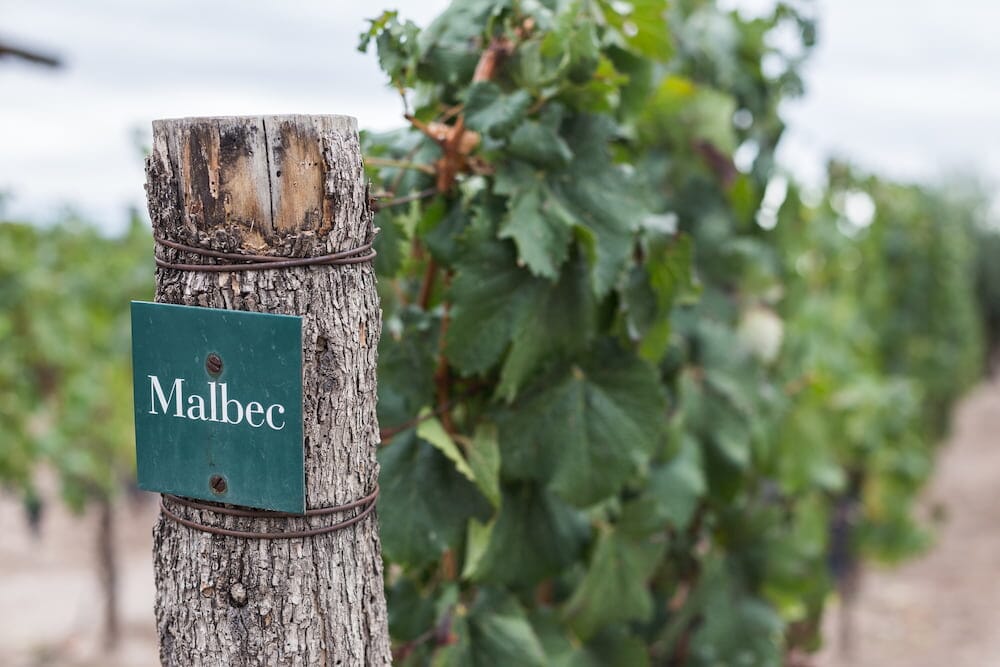Malbec is a full-bodied red wine, a close companion to Merlot. Although medium-bodied red wines like Merlot are more likely to be known for their moderate acidity, medium tannin, and fruity aroma, things are quite different with a full-bodied Malbec.
The body of a Malbec wine is generally a little lighter than Cabernet Sauvignon and the sweetness is comparable to the Italian Chianti wines. Plump cherries and blackberries build the core of the wine’s taste. Dominantly a dry wine, Malbec has medium to high acidity and tannin. In some variations or blends, it can also easily be medium-bodied.
In comparison to Merlot, Malbec is moderately dry (Merlot being very dry). In other words, you can indeed expect the Malbec to be sweeter tasting.
Before we move into its character, we have to better understand what influenced it.
Malbec is originally a French wine, like many Bordeaux red wines. It was introduced to Argentina back in 1868 by French agriculture engineer and botanist Michel Pouget at the then governor’s request. It became a trendsetter and continues to be planted popularly throughout entire regions in Argentina.
Bordeaux Malbec is inherently rustic. Softer than Merlot in terms of tannins. The Cahors Malbec is significantly more tannic and darker in colour. On the other hand, Argentinian Malbec red wine is much softer than either, flaunts a plusher texture, and has riper tannins.
Facts About Malbec Wine
Let’s go through the basics first:
- Acidity: medium
- Tannins: medium
- Temperature: slightly cool
- Fruits: blackberry, black cherry, pomegranate, raisin, blueberry, raspberry, plum
- Texture: juicy, jammy
- Notes: vanilla, tobacco, oak, dark chocolate (regardless of oak ageing)
- Grape skin: thick
The Malbec grapes have an inky dark colour with black skin. This particular breed of grape (one of the six “allowed” grapes for Bordeaux wines) was killed off in a frost throughout the Malbec-growing regions in France. As a result, Malbec wine became much less popular than others. In Cahors, however, they kept replanting Malbec and as a result, we have some legitimately perfect variations of French Malbec wine.
In France, the majority of Malbec is grown in Cahors. The grape ripens mid-season and requires plenty more sun and heat than either the Merlot or the Cabernet Sauvignon. For this reason, it’s also used to bring in some complexity to claret blends.
Malbec is a grape known to be marred with crop disease. Due to the poor resistance of the crop, Malbec wine never really managed to climb to the top in terms of production within France. But thanks to Argentina, it stays as one of the top 18 noble grapes. Not only is it grown in many more countries now, but it’s also becoming more popular day by day. In many ways, one could say that Argentina saved the Malbec.
Acidity is important for wines. In elevations with a wide temperature shift (like hot days with very cold nights), the Malbec grape finds the perfect climate for creating more acidity.
You’d be surprised to know that even though Malbec has such a unique personality, it’s mostly used in creating blends. Merlot remains to be the preference for blends.
The Malbec wine is although also known by thousands of other different names as per the French ampelographer Pierre Galet, some more popular names include Côt, Auxerrois, Pressac, Agreste, Calarin, Grelot De Tours, Navarien, Pied Rouget, Queue Rouge, Terranis, and Vesparo.
Variations In Malbec Wine
There are significant tasting variations depending on which region your bottle is coming from.
The Argentinian blends all have a strong fruity aroma. The main flavors include blackberry, black cherry, and plum. Further, a sweet tobacco finish is traditional with oak ageing.
In France, both the Cahors and Bordeaux variations had certain peculiarities. However, as mentioned above, Cahors is where Malbec is grown primarily. Cahors Malbec is predominantly leathery. It has accentuations of tart currant and black plum. Compared to the Argentine counterpart, it also has considerably higher acidity, thanks to which it’s easy to symbolise the wine with flavours of black pepper and spice.
All that being said, you can probably find out it's Malbec by the strong tell the wine has. Malbec wine is nearly opaque and deep purple-red but will have a bright magenta rim.
Selecting A Malbec Wine
Arguably, the most popular variation of the Malbec wine is the one grown in the Mendoza province in Argentina. A typical bottle of Argentine Malbec with 6 months of oak ageing will cost you anywhere from £7 to £10. Ones aged longer (around 20 months) cost £18 or more.
Mendoza makes up around 75% of Argentina’s total Malbec output, and it can be found in the foothill of the Andes.
Another type of Malbec that is particularly enjoyed by UK oenophiles is the Magma Tupungato which also comes from the Andes. As you can guess from the name, magma is found within the soil where the vines grow. The result is fully flavoured wine that provides a smooth finish.
There are also a range of French varieties that can provide a different taste.
And what about the food options with Malbec?
Unlike medium-bodied red wines, which are a great accompaniment to almost any type of food, full-bodied wines have limited pairings.
Lean red meat and dark poultry are both excellent choices for Malbec wine to go with. You won’t go wrong with chicken legs, lamb, pork shoulder, buffalo, ostrich, or duck either.
As far as vegetables are concerned, Malbec wine produces excellent taste when paired with any roasted vegetable, pretty much. Additionally, mushroom, green and red bell peppers, kale, beet, lentils, black beans, and arugula are great to pair Malbec with.
It doesn’t hurt to include any spices that have a smoky or earthy flavour. Candidates include parsley, thyme, rosemary, smoked paprika, black pepper, cumin, coriander, clove, vanilla bean, garlic, and green onion.
Cheese enthusiasts will note that goat’s milk cheese and semi-firm cow’s milk cheese are perfect for the Malbec wine.
Where Is My Malbec Coming From?
As noted above, Argentina saved Malbec in many ways. As a result, it’s only natural that close to 75% of Malbec wines come from Argentina. It has an area of 76,700 acres including the provinces of Mendoza, San Juan, and Salta currently growing Malbec grapes.
In France, there is approximately 15,000 acres of Malbec plantation including the regions of Sud-Ouest, Loire Valley, and Bordeaux.
There was a time when the French were producing Malbec wine grown from grapes that came from no less than 30 different departments, a unit of local government within the 18 regions (comparable to states). With time, however, French Malbec has become less and less popular. Vineyards in Cahors are seemingly the only place working hard to produce Malbec. However, due to this excellent track record and the legacy, Malbec has over a thousand local names even to this date.
Other Details About Malbec Wine
Whether you plan to enjoy Malbec on its own or pair it with food, you’ll need some more information to proceed.
For example, how does it stand in terms of health benefits against other popular red wines? What’s the alcohol percentage? And so on. Let’s answer these questions.
What is the alcohol percentage of Malbec?
Malbec wines usually consist of 13-14% alcohol. This is comparable to Merlot, Cabernet Sauvignon, and Chardonnay. For reference, an ABV of 14.5% or higher is considered high alcohol, and certain blends of Merlot, Cabernet Sauvignon, Shiraz, Syrah, and Zinfandel do include higher ABV than that. Fortified wines also typically have a high alcohol percentage, like the Sicilian Marsala, the Portuguese Madeira, the French Muscat, and the Spanish Sherry.
What are the health benefits of Malbec wine?
As the Malbec grape is a thick-skinned variety, Malbec wines are abundant in resveratrol antioxidants. These antioxidants improve the body’s cardiovascular health and boost immunity.
If one had to compare, you will find around four times the antioxidants in Malbec than in Merlot and around twice as much against Cabernet Sauvignon blends.
Well known Argentine brands of Malbec wine
When you’re going for Argentinian Malbec, you can’t choose just about any. Here are some popular brands known for their quality and good practices:
Bodega, Finca Sophenia, Casarena, Mendel, Luigi Bosca, Luca, Trivento, Renacer, Lindaflor, and Kaiken. Although there are other brands as well, availability and quality control differ from brand to brand.
How popular is Malbec in comparison to some of the top red wines?
Though Malbec wines are traditionally less popular than others, there has been an upsurge in people looking for the Mendoza Malbec, now more than ever. Though a lot of countries produce Malbec grapes and wines, it’s the country-specific variation of Malbec that comes from Argentina acting as the major propellant behind this interest.
Conclusion
Wine lovers in the UK and around the world are becoming increasingly interested in this particular brand of red wine and for good reason. Hopefully our guide has explained exactly why. As the UK's leading online supplier of wine coolers, wine cabinets and wine walls, we produce regular content about different types of wine.

